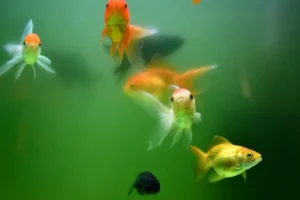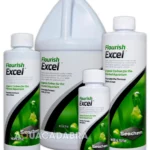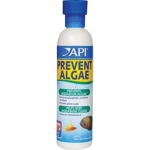Algae is one of the oldest and most common forms of life on earth and is inevitable in any body of water that contains nutrients and receives light allowing the algae to photosynthesise.
Just place some water in a saucer on a windowsill and after a few days algae will begin to develop.
It is, therefore, inevitable that algae will develop in our freshwater aquariums, and whilst some algae is normal and healthy, an excess of algae is both unsightly and can be harmful to both fish and plants.
Table of Contents
Types of Algae in a Freshwater Aquarium
Lets look at the most common types of algae in a freshwater aquarium:-

Green Water
Green water is often referred to as an ‘algae bloom’ and is caused by an explosion of free-floating, single-celled phytoplankton.
As the phytoplankton float freely in the water column they cannot be wiped off the glass or other surfaces.
Water changes are unlikely to help either as the remaining phytoplankton will simply re-multiply.
Usually caused by an excess of light or an imbalance in nutrients, green water can usually be cured by blacking out the tank for up to a week. However, it may soon return unless the initial causes are addressed.
Hair Algae
Hair algae is a broad term covering many types of algae including staghorn algae, string algae, and thread algae and in small quantities can be healthy for your aquarium.
Many algae-eating fish and shrimp will consume it and these in turn are a good way to keep it under control.
However, an excess of hair algae can become unsightly and even stifle the growth of live plants.
Hair algae are usually caused by an excess of light or a nutrient imbalance.
Green Spot Algae
Green spot algae are tiny spots of algae that will grow on both the glass and other surfaces including the leaves of plants.
They can be quite hard to remove, even with a glass scraper so prevention is key to stopping green spot algae from overwhelming your aquarium.
Again, green spot algae is usually caused by an excess of light or a nutrient imbalance.
Black Beard Algae

Black beard algae is both one of the most unsightly algae to have in an aquarium and also one of the most difficult to eradicate.
Algae-eating fish and shrimp will rarely touch it, although it has been known.
Dosing liquid carbon will help but the most successful method of removing black beard algae is by treating any infected plants in a solution of water and 3% hydrogen peroxide.
Black beard algae is usually introduced into an aquarium from new plants so be sure to inspect any carefully before you buy them.
Blue-Green Algae
Blue-green algae are also known as slime algae and are not actually algae at all, Rather it is cyanobacteria and is usually caused by an excess of phosphates or nitrates in the water.
Blacking out the aquarium for a few days will get rid of it but it will return unless the underlying causes are addressed.
Causes of Algae in a Freshwater Aquarium
The causes of algae in a freshwater aquarium are many and varied and some have been mentioned above but in general they are:-
Too Much Light
Excessive light is one of the biggest causes of algae in a freshwater aquarium, particularly if direct sunlight hits your aquarium for any length of time.
Avoid placing your aquarium in direct sunlight and only keep your aquarium lights on for 8 – 10 hours per day.
Overfeeding
Overfeeding your fish will lead to an increase of nutrients in your tank causing phosphates in particular to increase.
Algae feed on excess nutrients so only feed enough so that your fish consume it all in under 5 minutes. Any uneaten food should be removed immediately if possible.
Bad Husbandry
Not keeping up with regular maintenance and water changes will cause excess nutrients to increase further which will only help feed any algae.
Regular water changes are the best way to keep nitrates in check.
A Poor Water Source
Even if you do regular water changes you can still have problems if your source water is already high in nutrients.
Tap water contains varying degrees of dissolved solids, metals, phosphates, nitrates, etc which will all be potential food for algae.
Poor Water Quality
Aquarium water with high levels of nitrates, phosphates and other dissolved solids will encourage excessive algae growth so it’s vital to maintain good quality tank water.
How to Prevent Algae in a Freshwater Aquarium
Now let’s look at the ways you can prevent algae in a freshwater aquarium.
Grow Live Plants
Growing live plants in your aquarium is the best way to prevent excess algae from taking hold.
Plants use nitrates and phosphates as food and can therefore out-compete any algae and keep it in check.
For more information on growing live plants in an aquarium check out our article, How To Start A Planted Aquarium.
Find Great Live Plants on eBay
Good Lighting
As well as ensuring that your aquarium lights are only on 8 -12 hours a day you should also make sure you have the correct lighting.
Lighting that is either too powerful or not powerful enough can encourage algae growth and if you are keeping live plants you will need lights that provide the correct spectrum for optimum growth.
We recommend the light below for live plants:-
 | Fluval Plant 3.0 4 sizes Tanks from 38 – 153cm in length | Check pricing on eBay >> *Free UK Delivery |
Use RO Water
We strongly recommend you use RO water in your aquarium rather than tap water and you can find out much more about using it in our article, Using RO Water In Your Aquarium.
In short, using RO water means you are not introducing excess nitrates, phosphates and other harmful nutrients every time you do a water change.
Keep Algae-Eating Fish or Shrimp

Siamese Algae Eater
Why not let your tank inhabitants keep any algae in check? Fish like the Siamese Flying Fox (algae eater) or Otocinclus and Plecostomus will eat some algae types. As will Amano shrimp and some snail species.
However, be aware that these will not eat all algae types and some fish species may not be suitable for your aquarium. Plecos can grow to a very large size for example.
Regular Maintenance
Keeping up a regular maintenance schedule is an important tool in the battle against excess algae.
Weekly, or fortnightly 20 – 25% water changes will reduce nitrates, phosphates and other excess nutrients.
Regularly scrubbing the tank glass will not only improve the look of your aquarium but also prevent algae from gaining a foothold and spreading.
You should also remove rocks and scrub them and vacuum the substrate when you perform water changes and keep filters and pumps clean.
Testing your aquarium water on a fortnightly basis with a good test kit will allow you to monitor your water parameters and take any action needed to maintain good water quality.
Chemical Methods to Control Algae in a Freshwater Aquarium
If you follow our advice above you should be able to deal with all but the most severe of algae outbreaks but even then you may still need a little additional help.
Dosing liquid carbon is no substitute for using a CO2 injection system when growing live plants but it can help. Anything that improves plant growth will also help them out-compete algae and that has to be a good thing.
We recommend the liquid carbon below:-
 | Seachem Flourish Excel | Check pricing on eBay >> *Free UK Delivery |
As a short-term fix for algae problems, you may wish to try one of the many algae ‘cures’ on the market.
Whilst we are not in favour of using these on a regular basis, as the algae typically comes back, we have had some success in the past with the one below:-
 | API Prevent Algae | Check pricing on eBay >> *Free UK Delivery |
You may also wish to consider using a UV Sterilizer to help combat nuisance algae. Read our article Why Use a Fish Tank UV Sterilizer to find out more.
Control Algae in a Freshwater Aquarium FAQs
Why is my fish tank getting algae so fast? – There could be several reasons. Too much light or direct sunlight can be a big factor. Always place your tank away from direct sunlight and limit the lighting to 7 – 8 hours.
Other possible causes are over-feeding, poor water quality and a lack of general maintenance.
How do I reduce algae in my freshwater tank? – One of the easiest ways is to grow live plants. They will out-compete the algae for excess nutrients and generally improve water quality.
Good maintenance and regular water changes will also reduce excess nutrients starving algae of food.
Will water changes get rid of algae? – Yes, they will certainly help. Regular water changes reduce the excess nitrates and phosphates in your tank which algae need to grow.
Do aquarium plants reduce algae? – Yes, aquarium plants need nitrates and phosphates to grow and thrive. Algae also need them so the plants will out-compete the algae and keep it down.
Does using RO water help with algae? – It certainly helps. Tap water contains excess nitrates, phosphates, and other harmful nutrients which will inevitably lead to algae problems.
Using RO water gives you a starting base of zero to control your water parameters.
